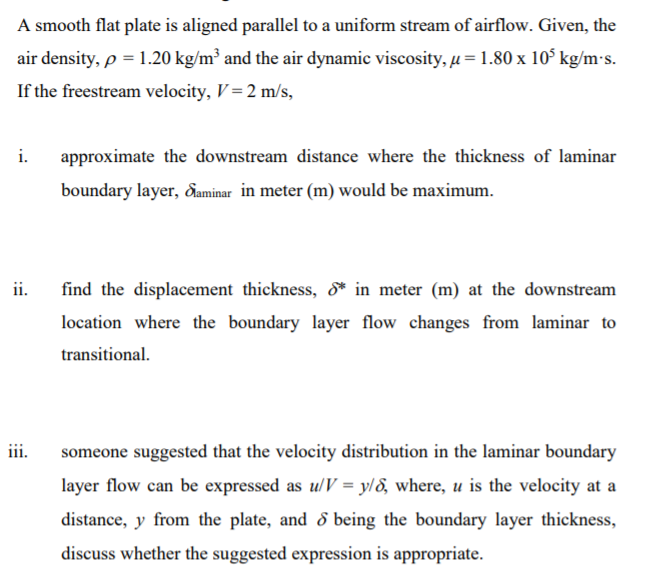ensity, p = 1.20 kg/m³ and the air dynamic viscosity, µ = 1.80 x 10$ kg/m•s. = freestream velocity, V = 2 m/s, approximate the downstream distance where the thickness of laminar boundary layer, &aminar in meter (m) would be maximum. find the displacement thickness, & in meter (m) at the downstream location where the boundary layer flow changes from laminar to transitional. someone suggested that the velocity distribution in the laminar boundary layer flow can be expressed as u/V = y/8, where, u is the velocity at a %3D distance, y from the plate, and 8 being the boundary layer thickness,
ensity, p = 1.20 kg/m³ and the air dynamic viscosity, µ = 1.80 x 10$ kg/m•s. = freestream velocity, V = 2 m/s, approximate the downstream distance where the thickness of laminar boundary layer, &aminar in meter (m) would be maximum. find the displacement thickness, & in meter (m) at the downstream location where the boundary layer flow changes from laminar to transitional. someone suggested that the velocity distribution in the laminar boundary layer flow can be expressed as u/V = y/8, where, u is the velocity at a %3D distance, y from the plate, and 8 being the boundary layer thickness,
Elements Of Electromagnetics
7th Edition
ISBN:9780190698614
Author:Sadiku, Matthew N. O.
Publisher:Sadiku, Matthew N. O.
ChapterMA: Math Assessment
Section: Chapter Questions
Problem 1.1MA
Related questions
Topic Video
Question
100%

Transcribed Image Text:A smooth flat plate is aligned parallel to a uniform stream of airflow. Given, the
air density, p = 1.20 kg/m³ and the air dynamic viscosity, µ= 1.80 x 10$ kg/m·s.
If the freestream velocity, V = 2 m/s,
i.
approximate the downstream distance where the thickness of laminar
boundary layer, &aminar in meter (m) would be maximum.
ii.
find the displacement thickness, &* in meter (m) at the downstream
location where the boundary layer flow changes from laminar to
transitional.
iii.
someone suggested that the velocity distribution in the laminar boundary
layer flow can be expressed as u/V = y/8, where, u is the velocity at a
distance, y from the plate, and 8 being the boundary layer thickness,
discuss whether the suggested expression is appropriate.
Expert Solution
This question has been solved!
Explore an expertly crafted, step-by-step solution for a thorough understanding of key concepts.
This is a popular solution!
Trending now
This is a popular solution!
Step by step
Solved in 2 steps with 2 images

Knowledge Booster
Learn more about
Need a deep-dive on the concept behind this application? Look no further. Learn more about this topic, mechanical-engineering and related others by exploring similar questions and additional content below.Recommended textbooks for you

Elements Of Electromagnetics
Mechanical Engineering
ISBN:
9780190698614
Author:
Sadiku, Matthew N. O.
Publisher:
Oxford University Press

Mechanics of Materials (10th Edition)
Mechanical Engineering
ISBN:
9780134319650
Author:
Russell C. Hibbeler
Publisher:
PEARSON

Thermodynamics: An Engineering Approach
Mechanical Engineering
ISBN:
9781259822674
Author:
Yunus A. Cengel Dr., Michael A. Boles
Publisher:
McGraw-Hill Education

Elements Of Electromagnetics
Mechanical Engineering
ISBN:
9780190698614
Author:
Sadiku, Matthew N. O.
Publisher:
Oxford University Press

Mechanics of Materials (10th Edition)
Mechanical Engineering
ISBN:
9780134319650
Author:
Russell C. Hibbeler
Publisher:
PEARSON

Thermodynamics: An Engineering Approach
Mechanical Engineering
ISBN:
9781259822674
Author:
Yunus A. Cengel Dr., Michael A. Boles
Publisher:
McGraw-Hill Education

Control Systems Engineering
Mechanical Engineering
ISBN:
9781118170519
Author:
Norman S. Nise
Publisher:
WILEY

Mechanics of Materials (MindTap Course List)
Mechanical Engineering
ISBN:
9781337093347
Author:
Barry J. Goodno, James M. Gere
Publisher:
Cengage Learning

Engineering Mechanics: Statics
Mechanical Engineering
ISBN:
9781118807330
Author:
James L. Meriam, L. G. Kraige, J. N. Bolton
Publisher:
WILEY